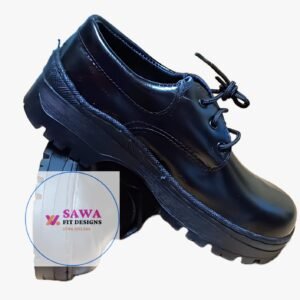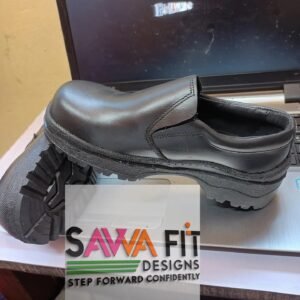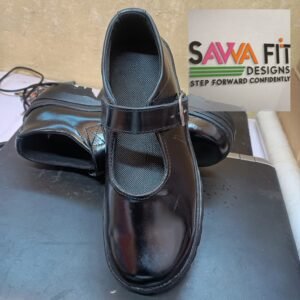Comfortable school shoes
-
Back to School Shoes -Genuine Pure Leather
Original price was: KSh1,300.KSh1,000Current price is: KSh1,000.Select options This product has multiple variants. The options may be chosen on the product pageClear3234242526272829303133 -
Boys Black School Shoes
Original price was: KSh1,500.KSh1,200Current price is: KSh1,200.Select options This product has multiple variants. The options may be chosen on the product pageClear363835373940 -
Slip-On School Shoes Boys
Original price was: KSh2,500.KSh2,000Current price is: KSh2,000.Select options This product has multiple variants. The options may be chosen on the product pageClear323436382728293031333537 -
Girls School Shoes (Buckle)
Original price was: KSh1,800.KSh1,400Current price is: KSh1,400.Select options This product has multiple variants. The options may be chosen on the product pageClear3837
Comfortable school shoes are essential for your child’s well-being. Kids spend a lot of time in their school shoes, from sitting in class to running around at playtime. Poorly fitting or unsupportive shoes can cause discomfort, lead to foot problems, and even affect concentration. Investing in the right pair means supporting your child’s developing feet and ensuring they have a comfortable school day.
Why School Shoes Matter
Your child’s feet are still growing and forming. Unlike adult feet, which are mostly developed, a child’s feet are soft and more easily influenced by external factors. This makes choosing appropriate footwear even more important. The right school shoes do more than just complete a uniform; they provide:
- Support: They help proper foot development and posture.
- Protection: They reduce the risk of injuries during physical activities on the playground.
- Comfort: They keep feet happy through long hours of wear, reducing fatigue and distraction.
- Hygiene: Breathable materials help prevent sweat buildup and odor.
Without comfortable, supportive shoes, your child could face issues like blisters, ingrown toenails, arch pain, or even long-term problems with their posture and gait.
Key Features of Comfortable School Shoes
When you’re looking for comfortable school shoes, focus on specific features that contribute to overall foot health and daily wearability.
1. Proper Fit
This is the most important factor. A shoe that doesn’t fit correctly, whether too big or too small, will cause problems.
- Length: There should be about a thumb’s width of space between your child’s longest toe and the end of the shoe. This allows for natural foot movement and a little growing room.
- Width: The shoe should fit snugly across the widest part of the foot without feeling tight or causing bulging. If it’s too wide, the foot will slide around, leading to friction and blisters.
- Heel Fit: The heel should feel secure, without slipping when your child walks. A firm heel counter, the back part of the shoe that cups the heel, helps stabilize the foot and ankle.
- Depth: Check that there is enough depth for the foot without too much empty space. You should be able to gently ripple the material on top of the foot with your thumb. If it’s too tight, there’s not enough depth. If there’s a big ridge of material, it’s too deep.
How to Check the Fit:
- Have your child wear the socks they’ll typically wear with their school shoes.
- Measure their feet later in the day, when feet are slightly swollen, mimicking their size after a full day of activity.
- Have your child stand up when trying on shoes.
- Feel around the shoe to ensure no pressure points.
- Ask your child to walk, run, and jump to see if the shoes feel comfortable and stay on securely.
2. Arch Support
Good arch support is important for developing feet. It helps distribute weight evenly and supports the natural curve of the foot, reducing strain. Many children have flexible flat feet, which often correct themselves with growth. However, if your child experiences pain or shows signs of poor posture, supportive school shoes or orthotics may be necessary. Look for shoes with built-in arch support or removable insoles that can accommodate custom orthotics if needed.
3. Breathable Materials
Long hours in closed shoes can lead to sweaty feet, odor, and even fungal infections. Choosing shoes made from breathable materials helps air circulate, keeping feet cool and dry.
- Leather: Genuine leather is a top choice due to its durability and natural breathability. It allows air circulation and molds to the foot over time.
- Mesh: Some athletic-style school shoes incorporate mesh panels, which offer excellent ventilation and are often lightweight.
- High-Quality Synthetics: Some synthetic materials are engineered with breathable properties. Avoid cheap plastics that trap moisture.
4. Durable Construction
School shoes face a lot of wear and tear. Kids run, jump, and play, so their shoes need to withstand daily activity.
- Sturdy Soles: Look for non-slip soles with good traction to prevent slips and falls on various surfaces. Rubber soles are generally a good choice.
- Flexibility: The sole should bend easily at the ball of the foot, allowing for natural movement. Avoid shoes that are too rigid or bend in the middle, as this compromises support.
- Reinforced Areas: Reinforced toe caps and quality stitching contribute to the shoe’s longevity.
5. Cushioning
Ample cushioning, especially in the insole and around the collar, provides comfort and absorbs impact. This is particularly important for active children who spend a lot of time on their feet. Padded ankle collars also prevent rubbing and provide extra comfort.
6. Easy Closure System
The fastening system matters for convenience and a secure fit.
- Velcro Straps: Great for younger children, promoting independence and allowing for quick adjustments.
- Laces: Offer the most customizable and secure fit, suitable for older children.
- Buckles: Can be a good option for traditional uniform styles, offering a decent level of control over the fit.
When to Replace School Shoes
Children’s feet grow quickly. You should check the fit of your child’s shoes every few months, even if they don’t complain.
- Toddlers (12 months to 3 years): May need new shoes every 3 months.
- Preschoolers (3-5 years): May need new shoes every 4-6 months.
- School-age children (5-10 years): May need new shoes every 6 months.
Look for these signs that it’s time for a new pair:
- Toes pressing against the end of the shoe.
- Red marks or blisters on the feet.
- Worn-out soles or compressed cushioning.
- Complaints of foot pain.
Tips for Shoe Shopping
- Involve Your Child: Let your child participate in the selection process. If they like the look and feel of the shoes, they will be more likely to wear them willingly.
- Consider School Policy: Some schools have specific guidelines on shoe styles and colors. Check these before you shop.
- Don’t Compromise on Fit and Support: While style matters, prioritize comfort, fit, and support over trends or price alone.
- Don’t “Buy Big”: While some growing room is good, buying shoes that are too big for your child to “grow into” can cause them to trip and lead to foot problems as their toes may grip to keep the shoe on.
Choosing the right comfortable school shoes is an investment in your child’s health and happiness. By focusing on proper fit, supportive features, and durable, breathable materials, you can ensure their feet are well-supported throughout the school day, letting them focus on learning and playing.
-
Back to School Shoes -Genuine Pure Leather
Original price was: KSh1,300.KSh1,000Current price is: KSh1,000.Select options This product has multiple variants. The options may be chosen on the product pageClear3234242526272829303133 -
Boys Black School Shoes
Original price was: KSh1,500.KSh1,200Current price is: KSh1,200.Select options This product has multiple variants. The options may be chosen on the product pageClear363835373940 -
Slip-On School Shoes Boys
Original price was: KSh2,500.KSh2,000Current price is: KSh2,000.Select options This product has multiple variants. The options may be chosen on the product pageClear323436382728293031333537 -
Girls School Shoes (Buckle)
Original price was: KSh1,800.KSh1,400Current price is: KSh1,400.Select options This product has multiple variants. The options may be chosen on the product pageClear3837
Comfortable school shoes



